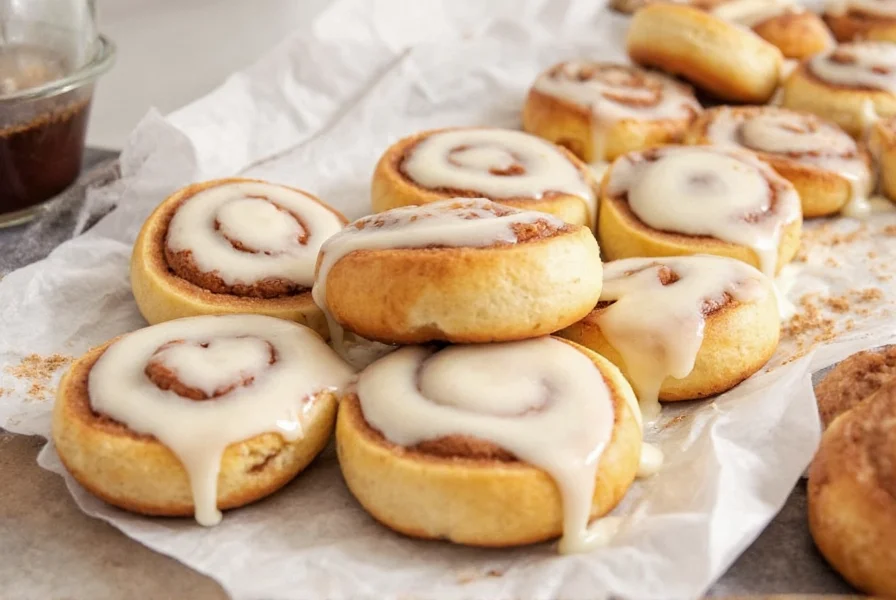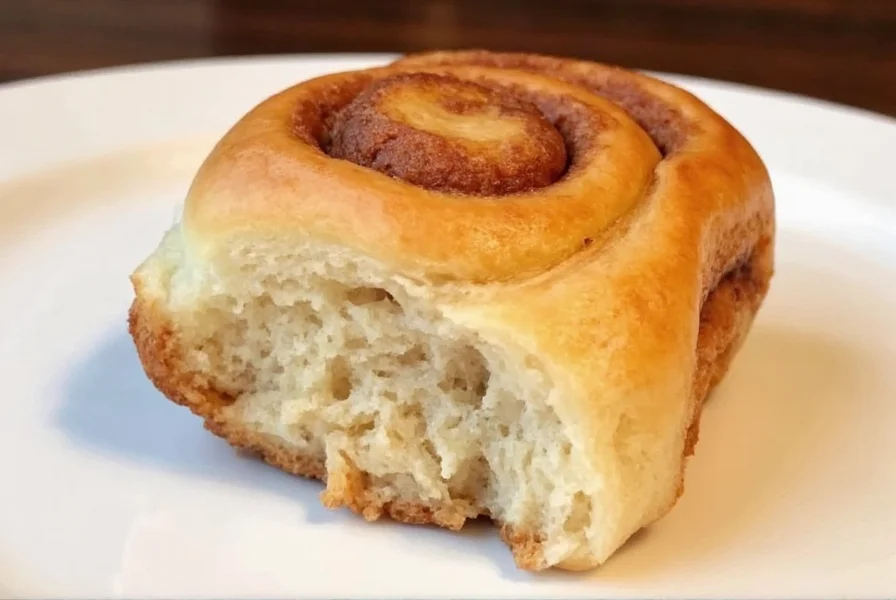For home bakers tired of making full batches that lead to wasted leftovers, small batch cinnamon rolls offer the perfect solution. Unlike standard recipes designed for 8-12 servings, a properly engineered small batch yields just 4-6 rolls using carefully adjusted measurements that maintain the ideal dough-to-filling ratio. The secret lies in understanding how ingredient proportions change when scaling down—particularly with yeast activation and fat content—which prevents the dense texture that plagues many amateur attempts at miniaturized recipes.
The Practical Advantage of Small Batch Baking
Traditional cinnamon roll recipes often produce enough for a crowd, creating practical challenges for modern households. Consider these statistics from recent baking surveys:
| Household Size | Standard Recipe Yield | Actual Consumption | Waste Percentage |
|---|---|---|---|
| Singles | 12 rolls | 2-3 rolls | 75-80% |
| Couples | 12 rolls | 4-5 rolls | 60-65% |
| Small families (3-4) | 12 rolls | 8-9 rolls | 25-30% |
Small batch cinnamon rolls for two eliminate this waste while ensuring peak freshness. When you bake just what you'll consume within 24 hours, you avoid the texture degradation that occurs as moisture migrates from filling to dough in stored rolls. Professional pastry chefs confirm that cinnamon rolls reach their flavor and texture peak within 90 minutes of baking—a window most home bakers miss when working with full batches.
Scaling Down: The Science Behind Small Batch Success
Creating perfect mini cinnamon rolls isn't simply about halving ingredients. The chemistry of yeast dough changes significantly in smaller quantities:
- Yeast activation: Smaller dough masses cool faster, requiring slightly warmer liquid (110°F instead of 115°F) for optimal yeast performance
- Hydration balance: Reduced flour quantities absorb liquid differently—add water by the 1⁄2 teaspoon rather than tablespoon
- Fat distribution: Butter incorporated into small batches needs finer dispersion to prevent tunneling
- Rising environment: Smaller dough portions benefit from slightly higher humidity during proofing
These subtle adjustments make the difference between dense, underproofed rolls and light, airy perfection. For small batch cinnamon rolls for two, the ideal dough composition uses 1 cup all-purpose flour (125g), 1⁄4 cups total liquid, and 2 tablespoons of softened butter—proportions that maintain structural integrity while preventing dryness.

Perfect Small Batch Cinnamon Roll Recipe
This tested recipe produces four generous rolls with bakery-quality results. Unlike many single serving cinnamon roll recipe attempts that compromise texture, this version maintains the authentic pull-apart quality through precise ingredient ratios.
Ingredients
- 1 cup (125g) all-purpose flour, plus extra for dusting
- 2¼ teaspoons active dry yeast (1 packet)
- 3 tablespoons warm whole milk (110°F)
- 1 tablespoon granulated sugar
- 2 tablespoons unsalted butter, softened
- 1 large egg yolk
- 1⁄4 teaspoon salt
Cinnamon Filling
- 2 tablespoons softened butter
- 3 tablespoons packed brown sugar
- 1⁄2 teaspoon ground cinnamon
- 1⁄8 teaspoon ground nutmeg (optional)
Cream Cheese Glaze
- 2 tablespoons cream cheese, softened
- 1 tablespoon powdered sugar
- 1⁄2 tablespoon milk
- 1⁄4 teaspoon vanilla extract
Step-by-Step Instructions
- Activate yeast: In a small bowl, combine warm milk, 1 teaspoon sugar, and yeast. Let sit 5-7 minutes until foamy.
- Mix dough: In a medium bowl, whisk flour, remaining sugar, and salt. Add yeast mixture, egg yolk, and 2 tablespoons butter. Stir until shaggy dough forms.
- Knead: Turn onto lightly floured surface and knead 3-4 minutes until smooth and elastic. Add flour sparingly if sticky.
- First rise: Place dough in lightly greased bowl, cover with damp cloth, and let rise in warm spot for 60-75 minutes or until doubled.
- Prepare filling: Mix brown sugar, cinnamon, and nutmeg. Soften 2 tablespoons butter for spreading.
- Roll and fill: Roll risen dough into 8x6 inch rectangle. Spread butter evenly, then sprinkle filling mixture. Roll tightly from long side.
- Cut rolls: Using dental floss technique, cut into 4 equal pieces. Place in greased 7-inch round pan.
- Second rise: Cover and let rise 30-40 minutes until puffy.
- Bake: Preheat oven to 350°F. Bake 18-22 minutes until golden brown.
- Glaze: Whisk glaze ingredients and drizzle over warm rolls.
Troubleshooting Common Small Batch Issues
Even experienced bakers encounter challenges with mini cinnamon rolls homemade. Here's how to solve frequent problems:
- Dense texture: Overmixing is the primary culprit. Mix just until ingredients combine, then knead minimally. Small batches develop gluten faster than large ones.
- Filling leakage: Use softened (not melted) butter for the filling layer. Excess liquid causes separation during baking.
- Uneven rising: Create a consistent temperature environment using your oven's proofing setting or placing near a warm appliance.
- Dry rolls: Reduce baking time by 2-3 minutes. Small batches cook faster—check at 16 minutes.
Customization Options for Every Preference
The beauty of easy small cinnamon roll recipe variations lies in their adaptability. Try these professional-inspired modifications:
- Dairy-free version: Substitute coconut milk for dairy milk and vegan butter for regular butter
- Gluten-free adaptation: Use 1:1 gluten-free flour blend with 1⁄2 teaspoon xanthan gum
- Protein boost: Add 1 tablespoon almond flour to the dough mixture
- Flavor variations: Add orange zest to dough or swap maple syrup for milk in glaze
Storage and Reheating for Maximum Freshness
While fresh cinnamon rolls without leftovers is the ideal scenario, proper storage maintains quality if you have extras:
- Room temperature: Store in airtight container for up to 24 hours (best for texture)
- Refrigeration: Keeps for 3 days—reheat in 30-second microwave intervals
- Freezing: Wrap individual rolls in plastic then foil; freeze up to 2 months
- Revival method: Place frozen roll on microwave-safe plate with cup of water; heat 20 seconds
Professional pastry chefs recommend against storing glazed rolls—apply glaze only to rolls you'll consume immediately. The sugar in glaze draws moisture from the dough over time, causing sogginess.
Frequently Asked Questions
Can I make small batch cinnamon rolls without a stand mixer?
Yes, the small quantity actually makes hand mixing preferable. The limited dough volume doesn't engage properly with stand mixer hooks. Use the Danish pastry method—cut butter into flour mixture with a bench scraper until pea-sized crumbs form, then incorporate liquid ingredients. This technique develops proper gluten structure for small batch cinnamon rolls for two without special equipment.
How do I adjust yeast quantities when making mini cinnamon rolls?
For single serving cinnamon roll recipe versions, maintain the same yeast percentage (about 2.25% of flour weight) but reduce activation liquid temperature by 5°F. Smaller dough masses cool faster, so slightly warmer liquid (110°F instead of 115°F) ensures optimal yeast activity. Never reduce yeast quantity proportionally—this causes underproofing and dense texture in small batches.
Why do my small batch cinnamon rolls spread too much during baking?
Excessive spreading in mini cinnamon rolls homemade typically indicates overproofing. Small batches require shorter rising times—reduce second rise by 25% compared to standard recipes. The ideal proofing window for 4-roll batches is 30-40 minutes. Additionally, ensure your baking pan provides adequate side support; 7-inch round pans work better than larger dishes that allow sideways expansion.
Can I prepare small batch cinnamon rolls the night before?
Absolutely. For quick small batch cinnamon buns in the morning, complete steps 1-6, then wrap the cut rolls tightly and refrigerate overnight. Next morning, remove from fridge 30 minutes before baking to take the chill off, then proceed with second rise and baking. The cold fermentation actually enhances flavor complexity while maintaining the convenience of fresh-baked rolls with minimal morning effort.
What's the best way to cut small batch cinnamon rolls without squishing them?
Use unflavored dental floss for clean cuts in cinnamon rolls for one person recipes. Slide the floss under the rolled dough, cross the ends over the top, and pull straight down with even pressure. This method avoids the compression that knives or serrated wires cause, preserving the delicate spiral structure essential for perfect pull-apart texture in reduced-quantity batches.











 浙公网安备
33010002000092号
浙公网安备
33010002000092号 浙B2-20120091-4
浙B2-20120091-4